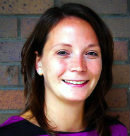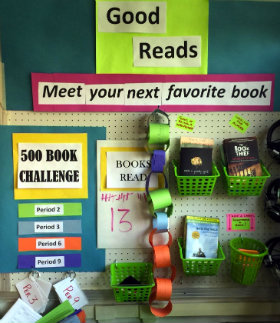Book Challenge Builds Passion for Reading
 By Rachel Wysocki Kent
By Rachel Wysocki Kent
If there is one sight that warms the heart of an English teacher anywhere, it’s the sight of a child holding an open book.
With all of the hullabaloo about Common Core, higher standards, standardized testing and rigorous texts, English teachers everywhere have lamented their students’ loss of a love for reading. I am not one of those teachers.
Whenever change occurs in education, teachers are presented with many choices: choices on how to react to the change, how to allocate time in the classroom, and how to focus on areas they believe are essential for student growth.
More emphasis on independent reading

This choice was made for a few reasons. First, we know that tweens and teens don’t like to be told what to do. Allowing them to exercise their ability to make thoughtful choices within the academic context would prepare them for more difficult academic choices they would need to make in the future.
Second, we knew we would be tackling challenging texts (that students certainly wouldn’t pick up on their own) during classroom instruction. Requiring students to read their chosen texts outside of class allows them to independently practice the skills we develop through reading the more difficult texts during class time.
Third, it provided us a venue through which we can assess students’ reading skills and understanding of key English content terms without having to select passages or create multiple choice questions. By asking students to write about the books they chose, instead of our in-class texts, we made sure we would have valid evidence of a student’s ability to apply concepts across a multitude of texts.
Lastly, the choice to put more emphasis on student independent reading promised to create a culture of reading inside of our classroom.
You know the challenges
Implementing a year-long Independent Reading program inside the English classroom doesn’t come without its challenges. It can be a challenge for each student to find “the book” to read. It can also be a challenge for teachers to keep the momentum going with a generation of social media-addicted students.
While I’m sharing what happened in our 10th grade classroom, I think many of our ideas can be adapted for students in the upper middle grades. The pool of books may be different to some degree, but the goal of building a reading culture in the secondary grades is certainly something we all share.
Here’s what we found out
First, it takes time. Time over the summer for teachers to read tons of young adult books in order to make good recommendations. Time in the library for students to browse. And time in the classroom for students to “get hooked” on their book or realize that they need to select a new one. Ideally, students will find a book that is accessible and engaging and that challenges them to think. This can take time, too.

From there, we needed to determine some broad and basic parameters for Independent Reading. In our case, for our 10th graders, we decided students would be asked to select and read one Independent Reading book each quarter. For quarter 1 it would be a book about a teenage protagonist or central character.
We knew that there were a plethora of fiction and non-fiction books that would fulfill these requirements, and we knew that no matter what book the student chose, their independent reading selection would help them to refine their understanding of what it means to be a young person in 2015, and how the roles of young people have changed throughout the course of history.
Once students found “the book” for them, one challenge remained… how do you keep them reading?
For us, this question was answered by another challenge.
The 500 Book Challenge
Once we introduced the Independent Reading requirement and got students “hooked” on their first book, we watched and waited for the day the tentative hand was raised to ask “What do I do if I’ve finished my book?” That’s when the real challenge began – for the students, not the teachers. We challenged our students throughout our four classes to collectively read 500 books throughout the course of the school year.
The 500 book challenge has become important part of our class culture, even though it does not take up a large amount of in-class time. In order to encourage students and keep a visual record of their progress we got creative and hearkened back to our grade school days by making paper chains. One link for each book read, one color for each class.
The low-key competition provides some extra energy and interest as the chains grow. Every day that students walk into the room, they have a visual reminder of how far they’ve collectively come throughout the year as readers.
At the half-way point of the school year, our students had collectively read over 200 books and practiced their reading skills on over 400,000 pages of text outside of the English classroom.
We have exciting plans for the end of the year when we know our students will meet the challenge set before them. We will have a book fair and invite authors to come and speak. We will have students make video book promos for next year’s group of students to watch.
We will also invite parents and administrators. We will collectively celebrate their amazing accomplishment as readers and their active dismissal of the stereotypes that “kids don’t read” and that “higher standards in the ELA classroom destroy the love of reading.”
Image credit:
Library reader source
__________________
Rachel Wysocki Kent has taught students with special needs in English Language Arts at Hamburg High School in Hamburg, NY for over ten years. A Teacher Consultant with the National Writing Project, Rachel provides professional growth courses on student engagement, college and career readiness, and standards based planning in many Teacher Centers throughout Western New York. She is a New York Educator Voice Fellow and is currently pursuing National Board Certification. Rachel has had the pleasure of co-teaching ELA alongside Genevieve Federick for eleven years.


































